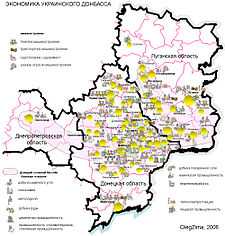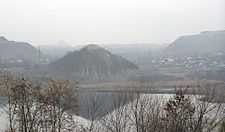Donets Basin


The Donets Basin (Ukrainian: Донецький басейн, translit. Donetskyi basein; Russian: Донецкий бассейн, translit. Donetskiy bassein), known commonly as the Donbas (Ukrainian: Донбас, Russian: Донбасс, Donbass), is a historical, economic and cultural region of eastern Ukraine. A coal mining area[1] since late 19th century, it has become a heavily industrialised territory suffering from urban decay and industrial pollution.
Donbas is currently the most densely populated of all the regions of Ukraine (excluding the capital city of Kiev). The city of Donetsk is considered the unofficial capital of Donbas.
Geography
Donbas covers three adminitsrative oblasts (provinces) in the east of the country: easternmost part of the Dnipropetrovsk Oblast around the city of Pavlohrad (the so-called "Western Donbas"), northern and central part of Donetsk Oblast (southern part is perceived to be Pryazovia coastland) and southern part of Luhansk Oblast (northern part is perceived to be Slobozhanschyna).
Natural geography
Before the intensive industrial development, Donbas area was once a typical part of the vast Great Eurasian Steppe.
Economic geography
"Donbas" may sometimes refer to a larger supranational region also consisting a part of neighbouring Rostov Oblast in Russia (the "Russian Donbass") also specializing in coal mining. This is explained by the fact that the Donets Coal Basin geographically extends to that area. But the "Russian Donbass" is of lesser economical and, most of all, sociopolitical significance compared to the part that after 1991 belongs to Ukraine.
Current natural resources
Despite history of extensive extraction, the Donets Basin still contains coal deposits suitable for decades of further mining. However, estimates on overall longevity of the large-scale mining in the region vary due to mounting costs, international competition and environmental concerns.
Urbanization and uneven development
Donbas is a heavily-urbanized territory with several conurbation areas. It is reflected in the region's complicated administrative division which is characteristic of small "cities" (towns) being subordinated to larger neighboring "cities", and so on to the level up.
History
The name of the region originates from the coal-field discovered in late 19th century which was named after the Donets river flowing across the region.
In 1676, the first town of the Donbas emerged: Solanoye (now Slavyansk) which was built for the profitable business of extracting newly discovered rock-salt reserves. In 1721, vast and rich coal fields were found, which started the "industrial boom" which led to the flourish of the region in 18th–first half of 20th century.
Ukrainian scholar and politician Hryhoriy Nemyria said:The fact that you came from the Donbas was more important than that you were Russian or Ukrainian; so of course the break-up of the Soviet Union also meant a raising of this regional identity and loyalty... In any case, most people here honestly couldn't say what they are ethnically, because most families, like mine, are mixed.[2]
Surveys of regional identities in Ukraine have shown that around 40% of Donbas residents claim to have a "Soviet identity".[3]
Demography
Coal mining-related issues
Occupational safety in coal industry
The coal mines of Donbas are one of the most hazardous in the world due to enormous working depths (down from 300 to 1200 m) as a result of natural depletion, as well as due to high levels of methane explosion, coal dust explosion and rock burst dangers.[4]
Despite these, even more hazardous illegal coal mines have massively appeared across the region in recent years.[1][5]
Environment destruction

Intensive coal mining and smelting in Donbas has led to severe multi-faceted damage to the local environment and residential comfort. The most common threats throughout the region include:
- water supply disruption and flooding due to the mine water
- visible air pollution around coke and steel mills
- air/water contamination and mudslide threat from the spoil tips
Additionally, several chemical industry waste grounds in Donbas has become undermaintained and pose a constant threat of major emissions to the environment.
One unusual threat is the result of the Soviet-era 1979 project of nuclear-explosion mining in Yenakieve.
See also
- Donbass Arena
- HC Donbass—an ice hockey team based in Donetsk bearing the name of the region
- Kryvbas—an important economic region in central Ukraine
- Ruhr Area—a comparable region in Central Europe
References
- ↑ 1.0 1.1 "The coal-mining racket threatening Ukraine's economy". BBC News. April 23, 2013. Retrieved September 18, 2013.
- ↑ Anatol Lieven, Chechnya: Tombstone of Russian Power (Yale University Press, 1999), p. 264.
- ↑ Soviet conspiracy theories and political culture in Ukraine:Understanding Viktor Yanukovych and the Party of Region by Taras Kuzio (23 August 2011)
- ↑ Grumau, S. (2002). Coal mining in Ukraine. Economic Review.44. Retrieved from http://web.ebscohost.com.erl.lib.byu.edu/ehost/pdfviewer/pdfviewer?sid=c56530f7-38d2- 4479-aacf-48ecbdfa0d18%40sessionmgr115&vid=1&hid=108
- ↑ Panova, Kateryna (8 July 2011). "Illegal mines profitable, but at massive cost to nation". Kyiv Post. Retrieved 18 September 2013.
External links
| Wikimedia Commons has media related to Donets Basin. |
| Look up donets basin in Wiktionary, the free dictionary. |
- History of Donbas
- Images of the Donbas in Soviet fine arts
- "The coal-mining racket threatening Ukraine's economy" by BBC News
- Why Donbass Votes for Yanukovych, historical overview of the roots, culture and character of the Donbas by Alexandr Osipian
| ||||||||||||||||||||||||||